An Exploration of Value in Regional Trade Agreements
This paper explores the effects of international trade and regional trade agreements including what role they have within the context of global trade. To provide better perspective on the issue, this paper provides an example and specifically examines the Regional Comprehensive Economic Partnership (RCEP) while demonstrating there is information to support the argument that a correlation exists between the regional trade agreement.
Read on and decide for yourself if there is indeed any reality to the statements that modern trade agreements benefit regional economic growth.
Opening Statement
Commonly business is offered one of two trajectories for growth. The first is horizontal and the second, vertical. The exploration of foreign direct investment is an exploration of the factors affecting organizations as they expand to meet demand and scale production in a manner which offers the greatest opportunity for stable or rapid growth with minimal risk.
FDI considerations are multi-level and far reaching with the first and most obvious being the ease and profitability of doing business regionally versus off-shoring resources and production. To briefly outline the challenges these options both immediately present is to look squarely at the labour availability in regional and domestic markets, also the cost of transportation and geographic proximity to base raw materials, finally the barriers to trade which are mainly established in the regulatory environment of governments and international trade agreements.
In this paper, we briefly explore the primary driver towards trends of deepening complexity within regional trade agreements as they gain in quantity and usage on the global international marketspace. Secondly, it must be made clear there are various subsects affecting the relationship with trade agreements and FDI, a strong correlation has been made with the content and application of these contractual devices in approaching international agreements as if creating better gateways for fluidity of exchange between nations and eliminating the burdensome weight of navigating multiple regulatory environments for businesses.
It becomes especially important to increase accessibility of regional trade for innovative new entrants and SMBs that struggle when confronted with impregnable walls of multiple national administrative regulation, customs processing requirements, and convoluted exchange restrictions, often all throughout the value chain.
A person without imagination can easily see why the Eurodollar and Brexit have been notable examples of the evolutionary switch into prioritization of various forms of deregulation and standardization for the purpose of trade, and to do so in such a way that all parties can establish some gainful benefit. It is further argued, and I agree – that deep trade agreements will gain popularity, and that the content which they possess that directly seeks to remove obstacles to doing business internationally, will make the difference in increasing amounts of foreign direct investment versus vertically developed businesses going forward. (Alberto Osnago, 2015)
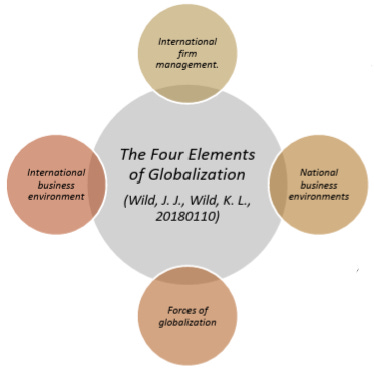
The Four Elements of Globalization
- Forces of globalization
- International firm management
- International business environment
- National Business Environments
(Wild, J. J., Wild, K. L., 20180110)
Is there a Benefit?
This paper establishes that there are benefits to regional trade and to establishing regional trade agreements between nations. These benefits are economic and can be observed from high level positions of governance and trade, causing localized improvements in purchasing power parity, higher availability of goods, greater supplier diversification, and ,more consistent trade of foreign goods to the individuals and businesses within these countries.
What are the Benefits of Regional Trade Agreements?
The benefits of regional trade agreements have been identified and enhanced as time has proven their value to the nations who engage in strengthening diplomatic and economic relationships with other countries. The depth of the benefit depends on the position and effort for fair equitable results for every signatory, and even protects and strengthens those who join with much less clout than the developed or wealthy nations.
For obvious reasons, we can trace the basic need to survive to the origins of trade, when the flow of goods and services was initiated by the need to build trade outside of individual lives, and eventually beyond domestic borders. Access to resources which would not be available otherwise, were increasingly abundant because humankind-initiated and developed the economies of scale we are seeing today. This is from the not-so distant evolutionary adjustment of industrialization and specialization where some countries are still emerging and growing into productive and attractive markets for investors.
There are many benefits to establishing regional trade agreements. Varying in their level of depth, these agreements can have far reaching effects into the stability and longevity of a nation’s social, environmental, and economic health.
– Author
Regional Trade Agreements:
Trade agreements are increasing in number as the economic benefits are experienced and the need for simplification grows. A marked increase in the total began just prior to 1995. This may be a result of the increased use of internet and communication between countries grew making it easier and more productive to engage in global trade.
Figure 1. Deep Trade Agreements are Increasing in Number Source: World Bank Group data:application/octet-stream;
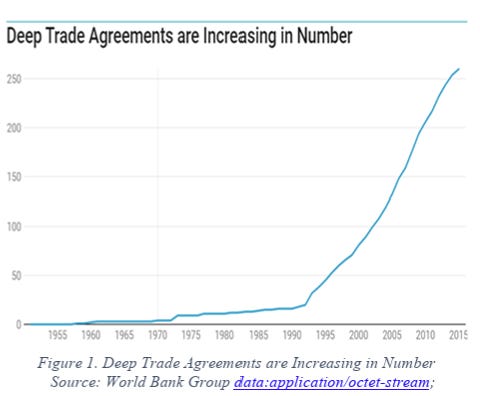
As a method for enriching the lives and quality of those they serve, Regional Trade Agreements have evolved to include more depth and meaning with varying degrees of reach into policy, procurement and governance depending on their purpose. Under the direction of international parties at work to create unilateral trade agreements which benefit all involved and effectively engage the industries they seek to draw resources from, these complex arrangements have more of a relational imperative. This demands a deeper level of understanding of international trade interdependencies from all signatories to establish contractual parameters for favorable outcomes and to then monitor the areas of impact once enacted.
Figure 2. Regional Trade Agreements are Becoming More Complex Source: Source: World Bank Group data:application/octet-stream
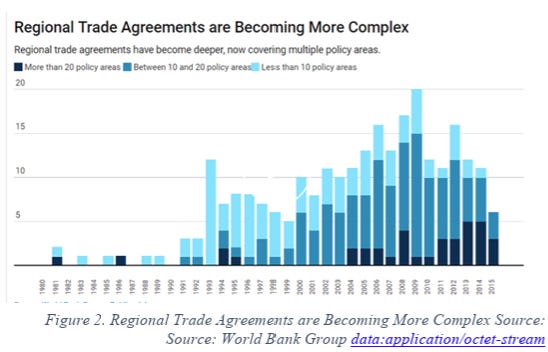
The World Bank found that, when compared to the “shallow” trade agreements which only address tariffs on goods and neither involve policy nor purposefully enable global value chains at their fundamental level, these “deep” trade agreements increase trade by 35 percent more, and services by 15 percent, they positively impact global value chain (GVC) integration by more than 10 percent over trade partnerships with only “shallow” agreements in place. (Smillie, 2018)
Figure 3. Countries connected to their primary trading partner in 2020 (https://www.visualcapitalist.com/wp-content/uploads/2022/02/2020-trading-partners.html)
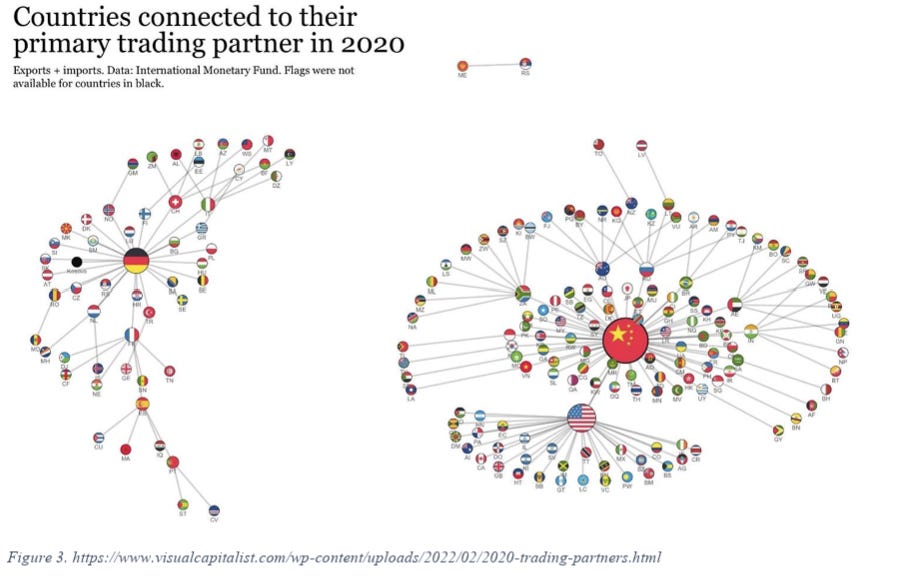
Regional Trade Agreement: Regional Comprehensive Economic Partnership (RCEP)
The Regional Comprehensive Economic Partnership (RCEP) agreement entered into force on January 1, 2022. The RCEP countries are home to nearly half of the world’s population and responsible for 30% of global GDP, this agreement has distinct purpose-led origins which classify it as a deep regional trade agreement.
The RCEP was created to bridge the gap between economically diverse nations while making improvements for trade, increasing market access for all businesses including small and mid-sized organizations, protecting regional supply chains, and it will do this by strategically strengthening economic cooperation to reduce trade barriers between the countries. (The ASEAN Secretariat, 2019)
The Regional Comprehensive Economic Partnership (RCEP) participating countries include:
- Australia
- Indonesia
- Cambodia
- Aesc
- Japan
- Malaysia
- China
- Singapore
- Brunet Darussalam
- Laos
- Korea
- Thailand
- Myanmar
- Philippines
- New Zealand
- Vietnam
Figure 4. Regional Comprehensive Economic Partnership (RCEP) Members
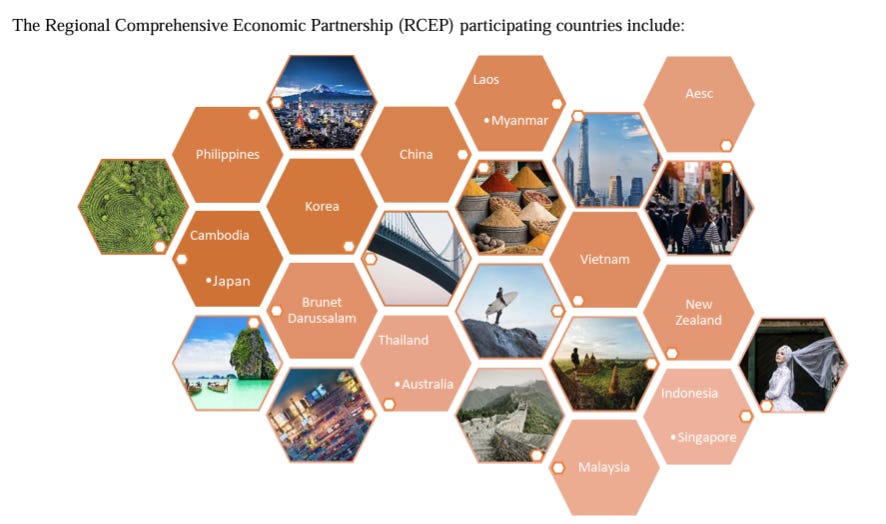

The RCEP highlights the importance of increasing transparency and being inclusive, especially to SMEs which are coping with added pressures of globalization and that make up nearly 90% of all the businesses in the agreement. They emphasize policy as an instrument to enhance and support the objectives of the FTA partners and ASEAN.
The Association of Southeast Asian Nations (ASEAN) includes free trade agreements with six partners.
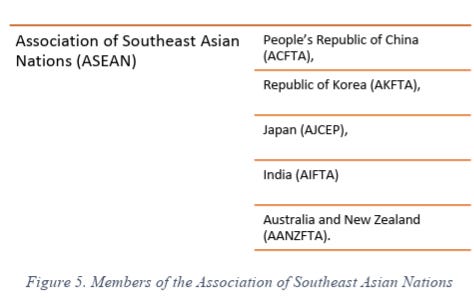
Members of the Association of Southeast Asian Nations (ASEAN)
People’s Republic of China (ACFTA),
Republic of Korea (AKFTA),
Japan (AJCEP),
India (AIFTA)
Australia and New Zealand (AANZFTA).
Figure 5. Members of the Association of Southeast Asian Nations.
Impact on Supply Chain Management and Business Development
The growing prevalence of regional trade agreements like RCEP presents both opportunities and challenges for supply chain managers and business developers. Understanding these implications is crucial for businesses seeking to leverage these agreements for competitive advantage.
Key Supply Chain Implications:
- Tariff Reductions:
Simplified customs procedures and reduced tariffs allow for more cost-effective sourcing and distribution networks across member countries.
- Regulatory Harmonization:
Standardized trade rules reduce compliance costs and streamline operations across multiple markets.
- Supply Chain Resilience:
Access to diversified supplier networks within trade blocs can mitigate risks associated with single-source dependencies.
- Digital Trade Provisions:
Many newer agreements include provisions for e-commerce, data flows, and digital supply chain management tools.
Strategic Considerations for Business Leaders:
- Companies should conduct thorough assessments of how specific trade agreements affect their industry sectors
- Documentation requirements for qualifying for preferential tariff treatment must be incorporated into supply chain processes
- Regional trade agreements often create opportunities to reconfigure supply chain networks to optimize tax and duty advantages
These developments are particularly relevant as the global business landscape continues to navigate post-pandemic recovery, geopolitical tensions, and the increasing emphasis on supply chain resilience over pure efficiency.
In Conclusion.
The critical necessity to continue to evolve into an increasingly integrated approach to international relations is more apparent when observing that access to accurate information builds trust necessary to solve bigger issues such as the standardization of ESG metrics, improving the contractability of regional sources of supply via smart contracts and regulatory compliance improvements that can be fast-tracked by blockchain technology, where widespread international trade disruption increases the risk for single sourced supplier production (areas of over-concentration) when it is maintained without geographical diversification.
All these risks and more can be identified and mitigated more readily with deeply integrated trade agreements that have meaningful objectives and clear methods to enact them, they can improve business outlooks for the nations who partake and will be a valuable tool used more frequently to build resiliency into global trade.





